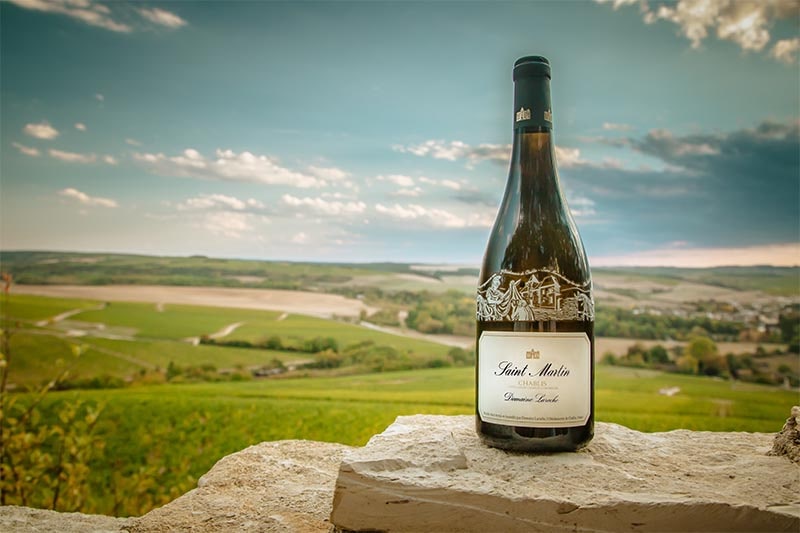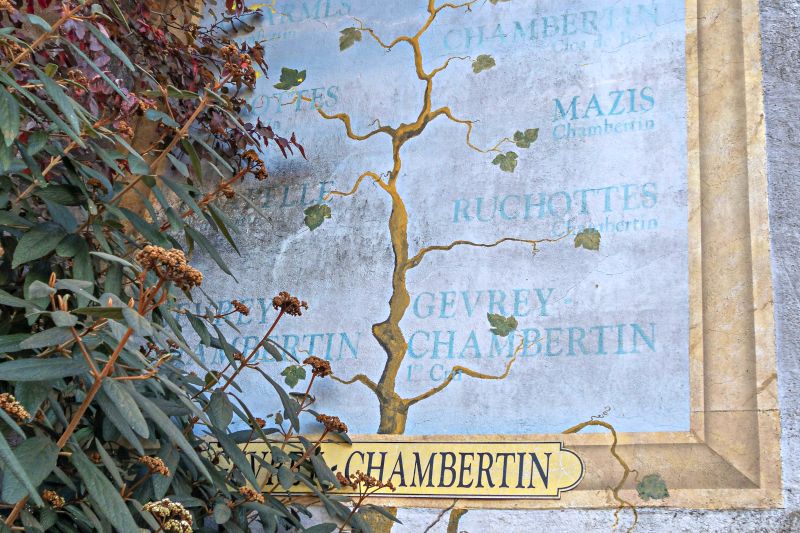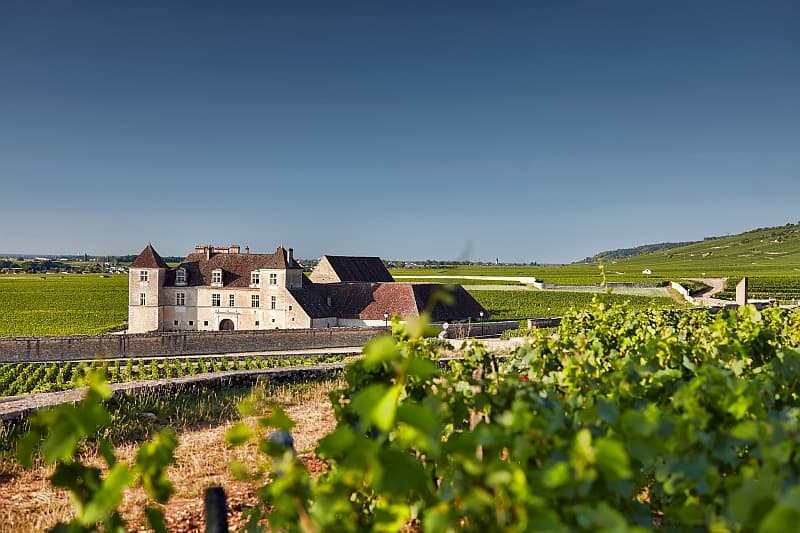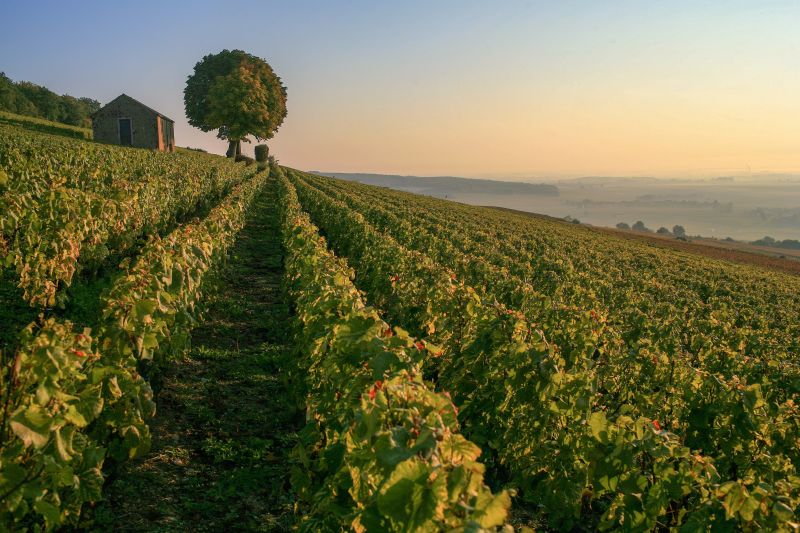Famed for its crisp white chardonnays and characterful pinot noirs, Burgundy is surely a bucket-list top pick for wine connoisseurs and enthusiasts alike. Measuring more than 230km from north to south, the Burgundy wine region is as varied as it is beautiful, and our luxury hotel barges cruise through some of its most picturesque and unspoiled reaches.
Discover Burgundy One Côte at a Time

From Seabed to Soil
Burgundy is, for the most part, sub-divided into numerous “côtes”. The word literally translates to mean “coast”, as in the Côte d’Azur or the Côte d’Ivoire. However, the more astute readers may realise that Burgundy is in the centre of the country, hundreds of miles away from France’s shoreline. The etymology of the word is therefore thought to be derived from a time when much of France was under water. Millions of years ago, during the Middle- to Upper-Jurassic periods, what is today the Burgundian wine region was a covered tropical lagoon with sandy beaches, palm trees, and home to a wealth of sea creatures. With shifting tectonic plates, the land was pushed upwards and the receding waters left behind the humps and bumps of the seabed, vast hills and “slopes” , which the word “côtes” has also latterly come to describe, littered with fossils and the remains of the ancient lagoon. The majority of these bedrocks and soil types which include limestone, sandstone, marl and clay which lie beneath its precious vineyards, are what give Burgundy wines their distinctive flavours and aromas.

Chablis & the Yonne Valley
In the rolling hills and broad horizons of northern Burgundy’s Yonne Valley, Chablis is renowned the world over for its delicate, bone dry white wines. Set around the tiny village of Chablis, more than 4,800 acres of vineyards produce its famous golden nectar, whose vines are tended to follow ancient traditions and whose wines are produced in centuries-old cellars with techniques handed down through generations. Guests aboard our 8-passenger hotel barge L’Art de Vivre and 12-passenger hotel barge La Belle Epoque have the unique opportunity to witness these famous vines first-hand, as they are accompanied through grand cru vineyards before indulging in a private tour and tasting at the 1000-year old Domaine Laroche.

Dijon & the Côte de Nuits
Further south east, neighbouring Dijon and the Côte de Nuits, which encompasses the the equally-famous village of Nuits-Saint-George, is famed for its ruby reds. Pinot noir is king here, and with villages including Vosne-Romanée, Chambolle-Musigny and Gevrey Chambertin, it is hard not to be absorbed into this incredible corner of Burgundy’s winemaking heritage. The Côte de Nuits’ reputation grew exponentially over the centuries, not only because of its close proximity to the commercial centre of Dijon, but also because the Emperor Napoleon made no secret of his admiration of its wines. So, as the legend of its greatness grew, it became known as the ‘Wine of Kings’.

The Fabled Clos de Vougeot
Guests aboard our 12-passenger hotel barge L’Impressionniste and 8-passenger hotel barge Finesse have the chance to explore perhaps the most illustrious Burgundian appellation – the fabled Clos de Vougeot, which in itself serves as a valuable illustration of why Burgundy’s system of wine production remains so excruciatingly complex and elusive. Its vineyard was founded by Cistercian monks from the Abbey of Cîteaux more than 800 years ago, and they continued to make wine in purpose-built cellars adjacent to the vineyard until the French Revolution. While today the 16th century château that occupies the site, and its immense 14th–18th century wine presses sit in silence, only to be admired by visitors, the vineyard continues to produce its famous fruit, which is transformed into wine by the more than 80 wineries that share its 124-acre plot.
The Côte de Beaune
Travelling south, the unmistakable bulk of the hill of Corton marks the beginning of the Côte de Beaune. Named after the medieval town of Beaune dubbed the ‘Capital of Burgundy Wine’, this côte is famed for its concentrated red wines from the likes of Volnay and Pommard, and the deep, oaky whites of Meursault, Puligny and Chassagne Montrachet.
Hautes Côtes de Beaune
Extending for a mere 20km southwards between Ladoix-Serrigny and the hillsides of the Maranges and, as the name would suggest, at a higher elevation, this region of the Burgundian vineyard is known primarily for its luscious whites and fruity red wines that are internationally renowned. Celebrated wineries in Beaune itself include Domaine Chanson and the oldest estate in Burgundy, Maison Champy. Passengers on-board our Finesse and L’Impressionniste luxury hotel barges have the unique chance to visit these extraordinary establishments, to see up close how the wine is transformed from berry to bottle. A little further to the west, behind the Côte de Beaune, vines flourish on a gently concave plateau 400m above sea-level on the where, on the sunniest slopes, around 20 communes produce lively and accessible wines. In the southern extremity of the region, Santenay, which overlooks the winding Canal du Centre from its sloping hillsides, is famed for its earthy red wines.

Côtes du Couchois
A little further to the west, on the other side of the Canal du Centre, lies the Côtes du Couchois. To the south of the Hautes Côtes de Beaune, this winegrowing terroir is nestled approximately 250 metres above sea-level. Here, six communes produce wines of character, the quality of which has been recognised since 2000 when it was awarded AOC status.
The Côte Chalonnaise
The final and most southerly côte of Burgundy’s strata, the Côte Chalonnaise is a wild and rugged landscape of undulating vines, pristine villages and the meandering Canal du Centre. Between the Côte de Beaune to the north and the hills of the Mâconnais to the south, the Côte Chalonnaise is some 25km long by 7km wide. Here, in the heart of a landscape spiked with hills, plots of vines have been planted on the best southeast-facing slopes and for a thousand years the vines have plunged their roots into soils similar to those of the nearby Côte de Beaune. Enjoying hot summers and dry weather in the fall, grapes here have no problems ripening.
In this land of contrasting landscapes, passengers onboard hotel barge Finesse will discover some renowned appellations made from pinot noir, chardonnay and aligoté as they navigate the Canal du Centre through the vineyards. In particular, guests can visit Bouzeron, a village with one of the few Burgundian appellations for the growing of Aligoté, whose wines are light and delicate, and make up the basis for the classic kir cocktail. Bouzeron is exceptional in Burgundy, since it is the only Village appellation that is entirely produced from this ancient varietal. It’s foremost estate, Domaine Chanzy, offers a range of wines from all over the Côte Chalonnaise, as well as from the neighbouring Côte d’Or.
Bordering Bouzeron, Rully is one of the best values for white wine in Burgundy, and is overlooked by its magnificent medieval castle. Though its wines may not last quite as long as the top premier or grand crus from the Côte d’Or, a number of producers turn out a luscious, clean and apple-scented chardonnay fruit whose prices can often be half a “Villages” wine from Puligny-Montrachet or Meursault. Thought to be the cradle of Burgundy’s sparkling wine, the lean Crémant de Bourgogne was first produced at Rully in the early 19th century.
Mercurey, approximately 10 miles from Beaune, is the most important winemaking village of the Côte Chalonnaise. Given AOC status in 1936, it has long been an insider’s favourite choice, particularly in view of the number of good producers who make wines here. Its vines spread over an area covering three square miles, with a great deal of vineyard expansion now taking place. While the reputation of Mercurey is for its red wines, which is indeed justified when tasting the finest examples, its best white wines certainly make a strong case that chardonnay can also do extremely well in the limestone, clay and sandy soil of the appellation.
Wine Appreciation Cruises with European Waterways
If you enjoyed this blog, you may be interested in our dedicated Wine Appreciation Cruises which take you on a week-long immersion into the history of the region’s wine offerings, with excursions that take you directly to the vineyards for private tastings with our sommeliers. Available in France and Italy, our Wine Appreciation Cruises are a true oenophile’s idyll.
To find out more, talk to a member of our Cruise Team, or order a free copy of our brochure to be delivered to your door.
 English
English
 Spanish
Spanish French
French German
German Norwegian
Norwegian Portuguese
Portuguese Swedish
Swedish Italian
Italian Russian
Russian Simplified Chinese
Simplified Chinese Japanese
Japanese


